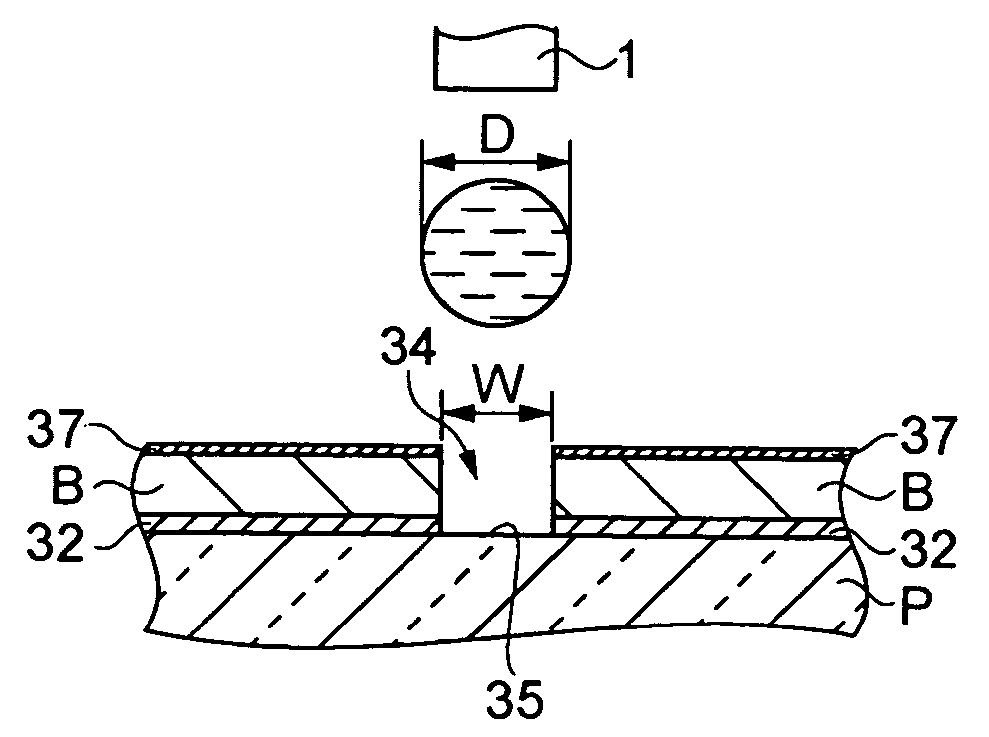Thin-film pattern forming method, semiconductor device, electro-optic device, and electronic apparatus
a technology of thin film and pattern, applied in the direction of resist details, printed circuit aspects, printed circuit manufacturing, etc., can solve the problems of inability to selectively treat the concave portion, inability to form thin film at all, and inability to meet the requirements of film thickness and sectional shape of thin film formed in the concave portion. to achieve the effect of sufficient film thickness
- Summary
- Abstract
- Description
- Claims
- Application Information
AI Technical Summary
Benefits of technology
Problems solved by technology
Method used
Image
Examples
first embodiment
[0052] A thin-film pattern forming method according to a first embodiment of the invention provides a wiring pattern formed by a conductive wiring film on a substrate. The wiring pattern forming method of this embodiment first provides a bank on the substrate so as to define a concave portion surrounded by the bank and having the same planar shape as the thin-film pattern. The method then discharges droplets of ink (functional liquid) for forming a wiring pattern that includes conductive particles from a discharge nozzle included in a droplet discharge head by droplet discharge to the concave portion so as to provide the wiring pattern formed by the conductive wiring film on the substrate. Here, the conductive wiring film corresponds to the first thin film. The wiring pattern corresponds to the thin-film pattern.
[0053] The ink (functional liquid) used as described above will now be described. The ink for forming a wiring pattern, which is a liquid material, is composed of a dispers...
second embodiment
[0100] A thin-film pattern forming method according to a second embodiment of the invention will now be described. In the present embodiment, a method for forming a wiring pattern that forms a circuit wiring further on the wiring pattern formed by the above-described wiring pattern formed in the first embodiment will be described. The droplet discharge method and device used in the present embodiment are fundamentally the same as those employed in the first embodiment.
[0101]FIG. 9 is a flowchart showing an example of the wiring pattern forming method of the present embodiment. According to the wiring pattern forming method of the present embodiment, a bank is provided on the substrate so as to define a concave portion surrounded by the bank and having the same planar shape as the thin-film pattern. Thus, a wiring pattern is formed by providing the ink for forming a wiring pattern, which is described in the first embodiment, in this concave portion and forming a wiring film on the s...
third embodiment
[0126] A liquid crystal display as an example of an electro-optic device according to a third embodiment of the invention will now be described. This liquid crystal display according to the present embodiment includes a TFT having a circuit wiring provided by the thin-film pattern forming method according to the first and second embodiments.
[0127]FIG. 12 is a plan view of the liquid crystal display according to the present embodiment with each component viewed from an opposing substrate. FIG. 13 is a sectional view along line H-H′ of FIG. 12. FIG. 14 is an equivalent circuit view showing each element, wiring, etc. in a plurality of pixels arranged in a matrix in an image display area of the liquid crystal display. FIG. 15 is a partially enlarged view of the liquid crystal display. It should be noted that different scales are used for the layers and members in the drawings, so that the layers and members can be recognized.
[0128] Referring to FIGS. 12 and 13, this liquid crystal dis...
PUM
| Property | Measurement | Unit |
|---|---|---|
| contact angle | aaaaa | aaaaa |
| contact angle | aaaaa | aaaaa |
| diameter | aaaaa | aaaaa |
Abstract
Description
Claims
Application Information
 Login to View More
Login to View More - R&D
- Intellectual Property
- Life Sciences
- Materials
- Tech Scout
- Unparalleled Data Quality
- Higher Quality Content
- 60% Fewer Hallucinations
Browse by: Latest US Patents, China's latest patents, Technical Efficacy Thesaurus, Application Domain, Technology Topic, Popular Technical Reports.
© 2025 PatSnap. All rights reserved.Legal|Privacy policy|Modern Slavery Act Transparency Statement|Sitemap|About US| Contact US: help@patsnap.com



